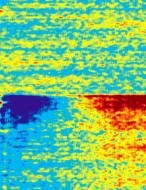How deep brain stimulation works for Parkinson's
Finding that nerve fibers are where changes may happen could enable less-invasive treatments
By Tina Hesman Saey April 11th, 2009; Vol.175 #8 (p. 11)
Getting a move on is difficult for people with Parkinson’s disease. Deep brain stimulation has helped restore movement for some patients, but no one was sure exactly how the technique worked.
Now two studies reveal the brain circuitry involved and suggest possible alternatives to the highly invasive surgery.
“Deep brain stimulation is basically a black box,” says Guoping Feng, a neurobiologist at Duke University in Durham, N.C. Scientists know that inserting an electrical probe deep into the brain and stimulating an area known as the subthalamic nucleus can help people with Parkinson’s disease overcome the disorder’s neurological block on movement.
But much controversy surrounds the mechanism by which the stimulation works. Some researchers think the technique stimulates neurons that initiate movement. Others say it blocks inhibitory neurons, allowing brain signals to resume. And yet another theory holds that it influences the flow of information along axons — fibers that connect neurons to each other.
A study published online March 19 in Science shows that deep brain stimulation exerts its effect on axons, specifically those that feed into the subthalamic nucleus, rather than on the neurons in the structure.
Stanford University researchers led by Karl Deisseroth used light-triggered molecules to turn on and off neurons in the deep brain structure in mice. The team employed the new molecular technique, developed to map neural circuits, to simulate the effect of deep brain stimulation. In a separate paper appearing in the March 19 Nature, Deisseroth and his colleagues show that these light-activated molecules can also be used to investigate biochemical processes in other cells in the body.
For the Science study, the team genetically engineered mice that have a condition that mimics Parkinson’s disease to produce light-responsive proteins only in certain cells in the brain. Then, the researchers inserted fiber optic threads into the mice’s brains. The team used a pulse of blue laser light to increase activity of the cells, or a burst of yellow laser light to quiet the cells. The scientists also used electrical probes to measure activity of the neurons.
When the researchers turned on the light in cells in the subthalamic nucleus nothing happened. But light stimulation of incoming axons improved the mice’s movements. Quieting activity of the axons made the movement disorder worse.
These axons are extensions of neurons located in the brain’s motor cortex, a region that controls movement. The cortex is the outer part of the brain and has six layers. Cells in layer V control the motor symptoms, the team reports. The finding suggests that less invasive procedures to stimulate parts of the brain closer to the surface might be an alternative to deep brain surgery.
“This is a big change in the way we look at the circuit,” says Romulo Fuentes, a neurophysiologist at Duke University.
Fuentes and his colleagues report in another study in the March 20 Science that a less invasive surgery might also relieve Parkinson’s disease symptoms. The researchers found that stimulating the spinal cord could restore movement to rats and mice with Parkinson’s–like problems. Deisseroth speculates that the neurons in layer V might form a bridge between the spinal cord and the deeper layers of the brain.
Spinal cord stimulation is already used in people to help alleviate chronic pain, so researchers may eventually be able to adapt the technique to treat Parkinson’s disease in people, Fuentes says.
“It’s good news for patients,” says Feng, who was not involved in either study. “Of course, it is not a cure.”
He says that the light-responsive techniques may help uncover the neural circuitry that leads to other psychiatric diseases, such as depression and obsessive-compulsive disorder, which are also sometimes treated with brain stimulation. And spinal cord stimulation or other minimally invasive therapies may offer psychiatric patients an alternative to deep brain surgery.

Finding that nerve fibers are where changes may happen could enable less-invasive treatments
Alleviating Parkinsons through deep brain stimulation from Science News on Vimeo - Video file courtesy of Duke University Medical Center.
By Tina Hesman Saey April 11th, 2009; Vol.175 #8 (p. 11)
Getting a move on is difficult for people with Parkinson’s disease. Deep brain stimulation has helped restore movement for some patients, but no one was sure exactly how the technique worked.
Now two studies reveal the brain circuitry involved and suggest possible alternatives to the highly invasive surgery.

“Deep brain stimulation is basically a black box,” says Guoping Feng, a neurobiologist at Duke University in Durham, N.C. Scientists know that inserting an electrical probe deep into the brain and stimulating an area known as the subthalamic nucleus can help people with Parkinson’s disease overcome the disorder’s neurological block on movement.
But much controversy surrounds the mechanism by which the stimulation works. Some researchers think the technique stimulates neurons that initiate movement. Others say it blocks inhibitory neurons, allowing brain signals to resume. And yet another theory holds that it influences the flow of information along axons — fibers that connect neurons to each other.
A study published online March 19 in Science shows that deep brain stimulation exerts its effect on axons, specifically those that feed into the subthalamic nucleus, rather than on the neurons in the structure.
Stanford University researchers led by Karl Deisseroth used light-triggered molecules to turn on and off neurons in the deep brain structure in mice. The team employed the new molecular technique, developed to map neural circuits, to simulate the effect of deep brain stimulation. In a separate paper appearing in the March 19 Nature, Deisseroth and his colleagues show that these light-activated molecules can also be used to investigate biochemical processes in other cells in the body.
For the Science study, the team genetically engineered mice that have a condition that mimics Parkinson’s disease to produce light-responsive proteins only in certain cells in the brain. Then, the researchers inserted fiber optic threads into the mice’s brains. The team used a pulse of blue laser light to increase activity of the cells, or a burst of yellow laser light to quiet the cells. The scientists also used electrical probes to measure activity of the neurons.
When the researchers turned on the light in cells in the subthalamic nucleus nothing happened. But light stimulation of incoming axons improved the mice’s movements. Quieting activity of the axons made the movement disorder worse.
These axons are extensions of neurons located in the brain’s motor cortex, a region that controls movement. The cortex is the outer part of the brain and has six layers. Cells in layer V control the motor symptoms, the team reports. The finding suggests that less invasive procedures to stimulate parts of the brain closer to the surface might be an alternative to deep brain surgery.
“This is a big change in the way we look at the circuit,” says Romulo Fuentes, a neurophysiologist at Duke University.
Fuentes and his colleagues report in another study in the March 20 Science that a less invasive surgery might also relieve Parkinson’s disease symptoms. The researchers found that stimulating the spinal cord could restore movement to rats and mice with Parkinson’s–like problems. Deisseroth speculates that the neurons in layer V might form a bridge between the spinal cord and the deeper layers of the brain.
Spinal cord stimulation is already used in people to help alleviate chronic pain, so researchers may eventually be able to adapt the technique to treat Parkinson’s disease in people, Fuentes says.
“It’s good news for patients,” says Feng, who was not involved in either study. “Of course, it is not a cure.”
He says that the light-responsive techniques may help uncover the neural circuitry that leads to other psychiatric diseases, such as depression and obsessive-compulsive disorder, which are also sometimes treated with brain stimulation. And spinal cord stimulation or other minimally invasive therapies may offer psychiatric patients an alternative to deep brain surgery.







Post a Comment